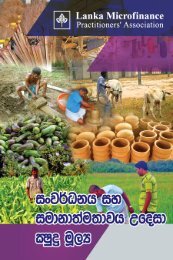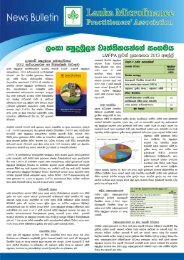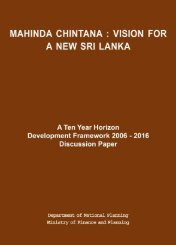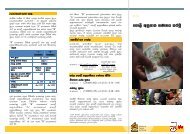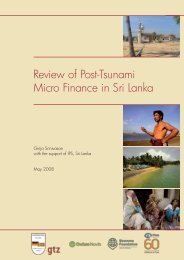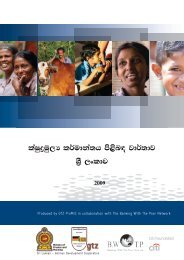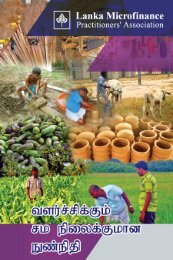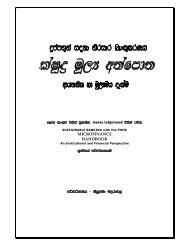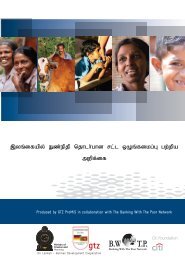National Microfinance Study of Sri Lanka: Survey of Practices and ...
National Microfinance Study of Sri Lanka: Survey of Practices and ...
National Microfinance Study of Sri Lanka: Survey of Practices and ...
Create successful ePaper yourself
Turn your PDF publications into a flip-book with our unique Google optimized e-Paper software.
Co-operative Rural Banks<br />
The CRB system commenced in March 1964 in Menikhinna in the K<strong>and</strong>y District<br />
<strong>and</strong> in the initial years was a partnership between the Peoples Bank <strong>and</strong> the cooperative<br />
movement. The Peoples Bank chose Multi-purpose Co-operatives with<br />
a significant membership <strong>and</strong> acceptable accounting <strong>and</strong> management to set up<br />
Co-operative Banks.<br />
The intention was that CRBs focus on small loans <strong>and</strong> savings that at that time<br />
was beyond the reach <strong>of</strong> the Peoples Bank. It was seen as a win–win equation for<br />
the Peoples Bank <strong>and</strong> the MPCS movement. The initial CRBs were even<br />
managed by staff member <strong>of</strong> the Peoples Bank. All accounting <strong>and</strong><br />
management/banking systems were introduced by the Peoples Bank <strong>and</strong> all<br />
training <strong>of</strong> staff undertaken by them, with the bank also introducing a deposit<br />
insurance scheme with all excess deposits invested in the Peoples Bank.<br />
The CRBs which were the banking division <strong>of</strong> the MPCS was set up as an<br />
independent pr<strong>of</strong>it centre <strong>and</strong> given semi-autonomy from the MPCS but had no<br />
separate legal status. The Manager <strong>of</strong> the CRBs at the MPCS report directly to the<br />
Board <strong>of</strong> Management <strong>of</strong> the MPCS rather than to its Chief Executive.<br />
However Peoples Bank (PB) relationship with CRBs changed a number <strong>of</strong> times<br />
<strong>and</strong> the practice <strong>of</strong> having PB staff as managers soon ended with instead<br />
experienced <strong>of</strong>ficers appointed as instructors to each CRB. Further after the reorganisation<br />
in 1971 the autonomy <strong>of</strong> the CRBs reduced with the CR Bank<br />
Manager responsible to the CEO <strong>of</strong> the MPCS <strong>and</strong> not directly to the Board.<br />
By year 1997 the relationship between the Peoples Bank <strong>and</strong> CRBs was<br />
terminated, leaving a major vacuum as no longer did CRBs have access to the<br />
banking technology <strong>and</strong> capacity building from an external source <strong>and</strong> training<br />
reduced to in-house training by senior <strong>of</strong>ficials.<br />
As a consequence <strong>of</strong> the PB moving away from its advisory <strong>and</strong> semi-banking<br />
role with CRBs the bank started setting up its own higher-level organisations<br />
starting with district unions. By the end <strong>of</strong> 1999 there were 14 such district<br />
unions providing banking services to the CRBs. A national federation was also<br />
formed <strong>and</strong> in 1999 an application was made to the central bank to set up a<br />
specialized co-operative development bank, the central bank did not approve the<br />
application. Meanwhile the original peoples bank that was set up to be a cooperative<br />
bank drifted away <strong>and</strong> focused on becoming a commercial bank.<br />
The growth <strong>of</strong> CRBs in the last 10 years is given below. What is remarkable is<br />
that the growth does not seem to be hampered by the advent <strong>of</strong> Samurdhi or the<br />
large number <strong>of</strong> NGO <strong>and</strong> government schemes. Both savings <strong>and</strong> loans have<br />
more than doubled since 1996.<br />
132




